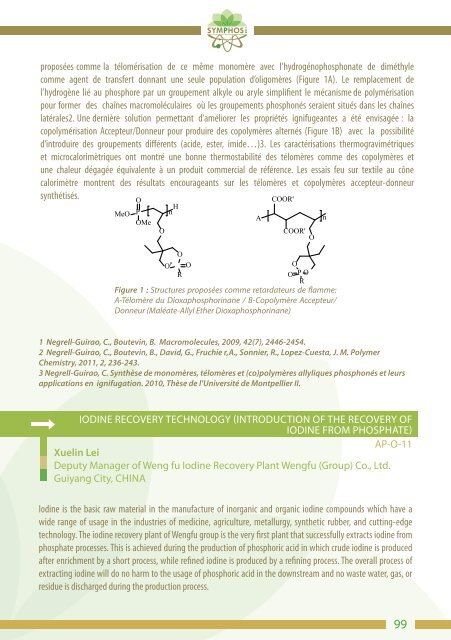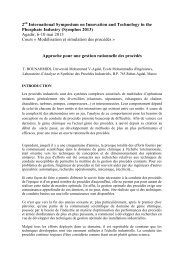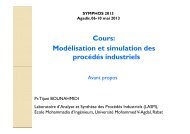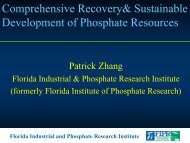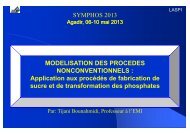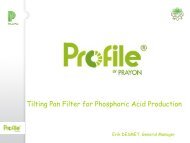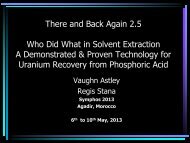Abstract SYMPHOS 2011
Abstract SYMPHOS 2011
Abstract SYMPHOS 2011
Create successful ePaper yourself
Turn your PDF publications into a flip-book with our unique Google optimized e-Paper software.
proposées comme la télomérisation de ce même monomère avec l’hydrogénophosphonate de diméthyle<br />
comme agent de transfert donnant une seule population d’oligomères (Figure 1A). Le remplacement de<br />
l’hydrogène lié au phosphore par un groupement alkyle ou aryle simplifient le mécanisme de polymérisation<br />
pour former des chaînes macromoléculaires où les groupements phosphonés seraient situés dans les chaînes<br />
latérales2. Une dernière solution permettant d’améliorer les propriétés ignifugeantes a été envisagée : la<br />
copolymérisation Accepteur/Donneur pour produire des copolymères alternés (Figure 1B) avec la possibilité<br />
d’introduire des groupements différents (acide, ester, imide…)3. Les caractérisations thermogravimétriques<br />
et microcalorimètriques ont montré une bonne thermostabilité des télomères comme des copolymères et<br />
une chaleur dégagée équivalente à un produit commercial de référence. Les essais feu sur textile au cône<br />
calorimètre montrent des résultats encourageants sur les télomères et copolymères accepteur-donneur<br />
synthétisés. COOR'<br />
MeO<br />
O<br />
H<br />
P n<br />
OMe<br />
O<br />
A<br />
COOR'<br />
O<br />
O<br />
O<br />
P O<br />
O<br />
R<br />
O P O<br />
R<br />
Figure 1 : Structures proposées comme retardateurs de flamme:<br />
A-Télomère du Dioxaphosphorinane / B-Copolymère Accepteur/<br />
Donneur (Maléate-Allyl Ether Dioxaphosphorinane)<br />
1 Negrell-Guirao, C., Boutevin, B. Macromolecules, 2009, 42(7), 2446-2454.<br />
2 Negrell-Guirao, C., Boutevin, B., David, G., Fruchie r,A., Sonnier, R., Lopez-Cuesta, J. M. Polymer<br />
Chemistry, <strong>2011</strong>, 2, 236-243.<br />
3 Negrell-Guirao, C. Synthèse de monomères, télomères et (co)polymères allyliques phosphonés et leurs<br />
applications en ignifugation. 2010, Thèse de l’Université de Montpellier II.<br />
IODINE RECOVERY TECHNOLOGY (INTRODUCTION OF THE RECOVERY OF<br />
IODINE FROM PHOSPHATE)<br />
AP-O-11<br />
Xuelin Lei<br />
Deputy Manager of Weng fu Iodine Recovery Plant Wengfu (Group) Co., Ltd.<br />
Guiyang City, CHINA<br />
Iodine is the basic raw material in the manufacture of inorganic and organic iodine compounds which have a<br />
wide range of usage in the industries of medicine, agriculture, metallurgy, synthetic rubber, and cutting-edge<br />
technology. The iodine recovery plant of Wengfu group is the very first plant that successfully extracts iodine from<br />
phosphate processes. This is achieved during the production of phosphoric acid in which crude iodine is produced<br />
after enrichment by a short process, while refined iodine is produced by a refining process. The overall process of<br />
extracting iodine will do no harm to the usage of phosphoric acid in the downstream and no waste water, gas, or<br />
residue is discharged during the production process.<br />
n<br />
99


